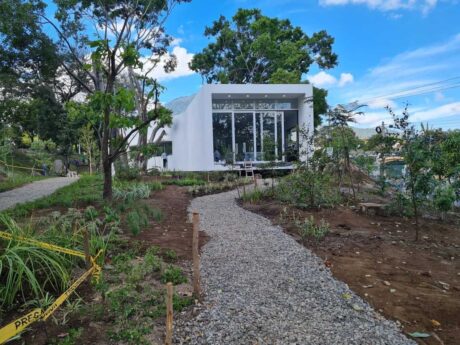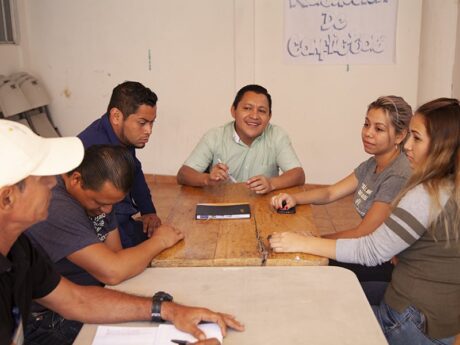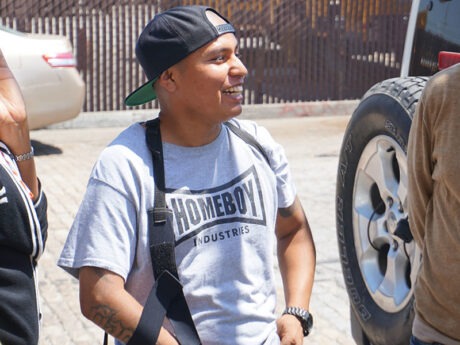Dentro de la estrategia colectiva para prevenir la violencia en El Salvador.
Alexis de la O Romero, 15, se da la mano con su maestro y golpea los puños con un amigo antes de deslizarse en un escritorio en la escuela y sacar su cuaderno y lápices de su mochila. Detraiga la tarea y está atento a la lección. Pero no hace mucho tiempo, El te lo dirá, Era una persona diferente.
"Siempre estuve en las calles. No escucharía a mi familia. No iría a clase," él dice.
En Cojutepeque, una ciudad tan reconocida por sus tasas de criminalidad como por su chorizo de fama mundial, Estos comportamientos pueden ser un indicador de riesgo de comprometerse con el ecosistema local de pandillas y la violencia.. Alexis preocupado caería en el mismo patrón que muchos otros jóvenes en Cojutepeque, Un maestro lo remitió a un programa de asesoramiento familiar., parte del Proyecto de Prevención del Crimen y la Violencia en El Salvador.
el proyecto, financiado por USAID e implementado por Creative, evaluó Alexis - y 1,040 Otros jóvenes: en su nivel de riesgo utilizando un método conocido como la herramienta de elegibilidad del servicio juvenil. La herramienta evalúa el riesgo de los jóvenes entre individuos, Dominios a nivel de pares y familiares que usan una serie de nueve factores de riesgo, como eventos de vida críticos, Abuso de sustancias e influencia negativa de los compañeros.
De los más de 1,000 Jóvenes el proyecto evaluado en ese ciclo, 142, incluyendo a Alexis, Factores mostrados que los ponen en alto riesgo de violencia, denominado riesgo de nivel secundario. De ese grupo, 105 optó por el programa de prevención de violencia secundaria.
En el transcurso de 18 meses, Alexis y su familia trabajaron en estrecha asociación con un consejero familiar capacitado para abordar la resolución de problemas, cambiar la dinámica familiar negativa y reducir los factores de riesgo de unirse a un grupo violento. Después de sólo los primeros seis meses, 92 por ciento de esos 105 juventud, incluyendo a Alexis, ya no demostró cuatro o más factores de riesgo, colocarlos por debajo del umbral de riesgo de comportamiento violento o unirse a pandillas: un servicio a la juventud, sus familias y comunidades.
“Es de mucha ayuda, ambos para ellos [la juventud] y para nosotros padres y, además, para el entorno familiar e incluso con los vecinos,” dice el padre de Alexis, Víctor Manuel Marroquín.
Dice que la relación entre él y su hijo cambió a medida que trabajaron juntos para abordar los problemas dentro de la familia y los que enfrentaba su hijo.. Alexis se volvió más abierto con su familia, y su comportamiento fuera de casa también mejoró.
“Siempre me metía en peleas. faltaría el respeto a los profesores,” dice Alexis de su pasado. “Pero el programa me ayudó a comprender que eso no me llevaría a ninguna parte.. Bien, Lo pensé y comencé a ir a clase.. Prestaría más atención a mis profesores.. ya no les faltaría el respeto. Me calmé”.
Mientras piensa en las posibilidades para su futuro., está agradecido de que se le hayan dado las herramientas y la oportunidad de cambiar.
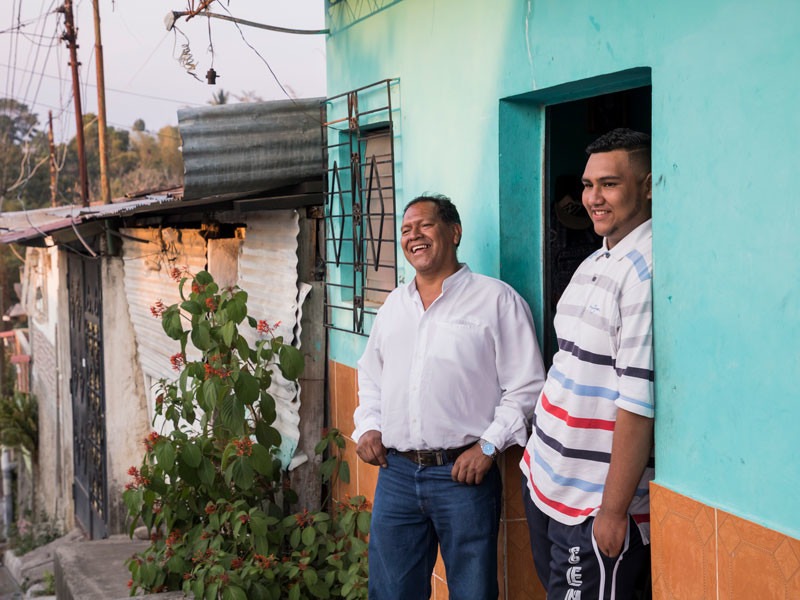
“Si no me hubiera unido al programa, No sé dónde estaría ahora," él dice.
Pero imaginar a dónde puede ir y lo que puede lograr es ser más fácil a medida que su comunidad también sufre una transformación, a través de la recuperación de espacios públicos, Recopilación de datos del crimen que hace que las calles sean más seguras, Habilidades y trabajos para la juventud, y medidas innovadoras para llegar a los jóvenes como él.
Diagnóstico del problema, Centrarse en los puntos calientes
A medida que los jóvenes como Alexis trabajan dentro de sus propios hogares para desarrollar la resistencia a la violencia, Comunidades como Cojutepeque están tomando medidas en las calles, informado por un mejor acceso a los datos del delito.
Extraer información sobre el crimen de una variedad de actores como la policía, hospitales y escuelas, El Observatorio Municipal Municipal y Violencia del Cojutepeque discierna patrones en actividades violentas que pueden y han ayudado al municipio a tomar medidas prácticas para que las familias puedan aventurarse, los niños pueden caminar a la escuela y los vendedores pueden vender sus productos en entornos más seguros. Con detalles sobre tipos de delitos., armas utilizadas, tiempo, ubicación y más, Los municipios han implementado medidas que incluyen desplegar más policías en lugares donde es más probable que se produzcan robos o instalar iluminación para iluminar las calles..
El observatorio es una pieza fundamental de un esfuerzo de varias partes en Cojutepeque y 54 otro alto- y municipios de riesgo medio, desde la bulliciosa San Salvador hasta la costera Conchagua, poner todas las manos y recursos a disposición para reducir el crimen y la violencia y ampliar las oportunidades para los residentes.
Dos filosofías en tándem guían estos esfuerzos del Proyecto de Prevención del Crimen y la Violenciat para crear lo que se conoce como un sistema basado en el lugar, enfoque de salud pública.
Ver la violencia como un riesgo para la salud pública muy parecido a una enfermedad, El proyecto utiliza datos para definir y diagnosticar el problema., Identificar y evaluar niveles de riesgo de comportamiento violento., implementar tratamientos o intervenciones y evaluar los resultados. Para interrumpir la propagación de la violencia, El proyecto se centra en los jóvenes en tres niveles de riesgo: la población general que vive en una zona peligrosa., aquellos en mayor riesgo de participar en la violencia, como alexis, y menores infractores en el camino hacia la rehabilitación y la reintegración.
Y apuntando a puntos estratégicos de violencia como Cojutepeque., El proyecto puede reducir más eficazmente la violencia en todo el país empezando por el nivel local.. Reúne a los ciudadanos, funcionarios del gobierno nacional y de la ciudad, policía, juventud, el sector privado y los medios de comunicación.
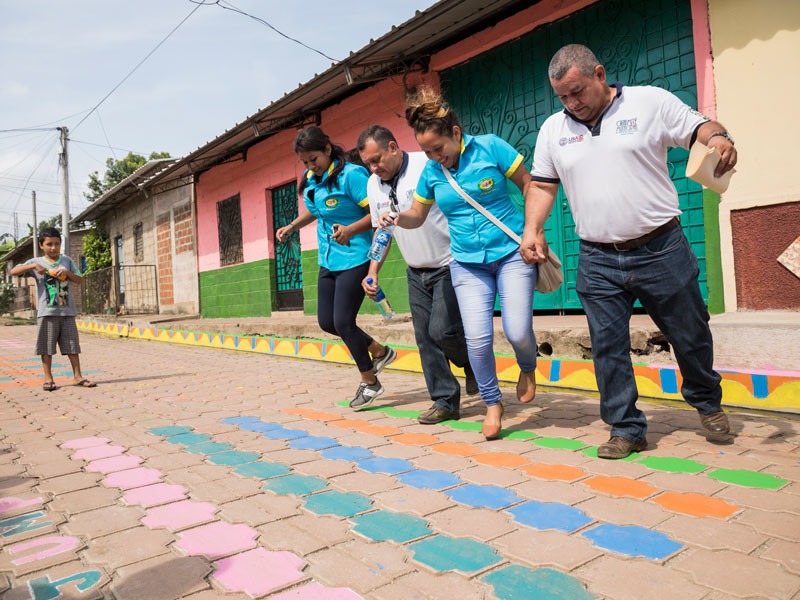
“La violencia severa relacionada con las pandillas marca profundamente la vida cotidiana en el cojútepe semi-rural,"Dice Javier Calvo, Jefe de Partido del proyecto. "Para abordar la violencia de manera más efectiva, Creemos que nuestros esfuerzos deben estar enraizados en una estrategia multinivel y basada en evidencia que promueva el compromiso de la comunidad de abajo hacia arriba., donde el público en general puede trabajar junto con la policía, Los líderes locales y otras partes interesadas para desarrollar colectivamente estrategias para reducir los factores de riesgo y aumentar la resiliencia y la cohesión social ".
Basado en las necesidades de un municipio, El proyecto apoya a los líderes locales para desplegar una combinación de su más 40 Herramientas de prevención como parte de seis estrategias interactivas que abordan todo, desde la falta de trabajos hasta la capacidad local limitada para rastrear y prevenir el crimen..
Ahora en su sexto año, más que 98,600 Salvadoreños han participado en iniciativas de proyectos, incluido 1,444 joven músicoEstá tocando en las filarmónicas del barrio en lugar de pasar el tiempo libre en las calles.; más que 29,200 beneficiarios jóvenes y 1,700 voluntarios mantienen activos los centros de extensión del vecindario; y 1,558 miembros de los Comités Municipales de Prevención del Delito y la Violencia liderando iniciativas de seguridad comunitaria.
Espacios seguros que ayudan a transformar comunidades
En un día cualquiera, en Cojutepeque y municipios de todo el país, 166 Los centros de extensión vecinales están llenos de actividad. Niños, Adolescentes y adultos jóvenes juegan partidos de fútbol., practicar sus habilidades en inglés, tomar cursos de habilidades para la vida, ensayar rutinas con sus discotecas o simplemente pasar el rato. Alguno 32,000 Los jóvenes asisten a estos centros en todo el país..
¿Qué tienen de notable estas escenas?? En muchos casos, antes de la llegada del Centro de Extensión, o Centro de Alcance en español, Los jóvenes en estos vecindarios carecían de un lugar seguro para jugar, socializar después de la escuela y pasar su tiempo productivamente. La alternativa son las calles, donde los futuros son inciertos y la violencia siempre es un riesgo.
Como parte de su participación en los centros, Los jóvenes trazan sus sueños y objetivos para la vida y mapean las vías para alcanzarlos, Solución de problemas con mentores para superar los obstáculos en el camino. Voluntarios del vecindario, a menudo jóvenes mismos, Mantenga vivas las actividades del centro.
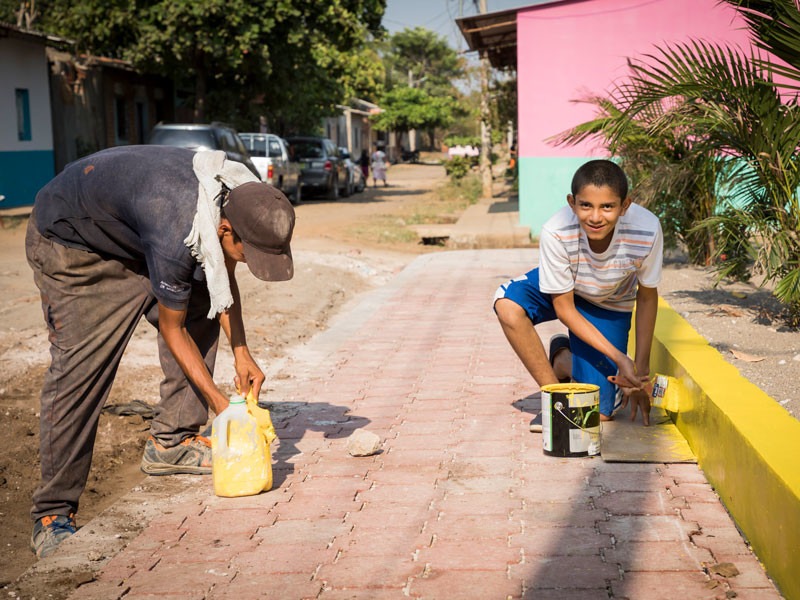
Estos voluntarios de los centros de divulgación también son clave para los proyectos y dirigidos por el municipio Proyectos de recuperación del espacio público que se han convertido en lotes abandonados en campos de fútbol y calles desoladas en vías coloridas para mercados comunitarios y celebraciones. Hasta la fecha, Las comunidades de todo el país han inaugurado 64 Tales proyectos, y un adicional 41 están en proceso en ocho municipios.
Magdalena Magaña, quien dirige las iniciativas de recuperación del espacio público del proyecto en todo el país, dice que este gran número de proyectos es una culminación de las colaboraciones de toda la ciudad..
"Al final, Todos trabajamos para crear y generar las condiciones y espacios para una recreación saludable y generar sonrisas en cada uno de los niños de la comunidad.," ella dice.
Ella le dice a los voluntarios que aunque estos proyectos toman un trabajo duro, Vale la pena para que la juventud de la comunidad, Las familias y los residentes pueden reclamar parte de su ciudad y enorgullecerse de lo que han construido juntos.
Una habilidad, cheque de pago y camino a seguir
Mientras tanto, A medida que los niños y los jóvenes pasan tiempo libre en los centros de divulgación y los parques públicos recién inaugurados, El proyecto también ayuda a expandir la oportunidad económica para los adultos jóvenes en estas áreas afectadas..
Jorge Jonathan Mendoza Ramos, 28, es uno de ellos.
En su primer día de clase de reparación de aire acondicionado, Examina herramientas desconocidas, tubos y fluidos que estudiará y manipulará durante las próximas semanas. Desempleado y ansioso por comenzar un negocio con amigos, Mendoza se inscribió en este curso en el Centro Municipal de Capacitación Vocacional de Cojutepeque, conocido por su formate de acrónimo español.
Aunque solo su primer día, Mendoza está ansioso por llegar a trabajar y dominar las habilidades que ayudarán a dar forma a su futuro.
"Ya tenemos mucho conocimiento. Hemos comenzado a aprender las nuevas herramientas y los diferentes tipos de aires acondicionados.," él dice. "Creo que dentro de un año, Podré recordar que este fue el comienzo de una empresa que queremos y tendremos”.
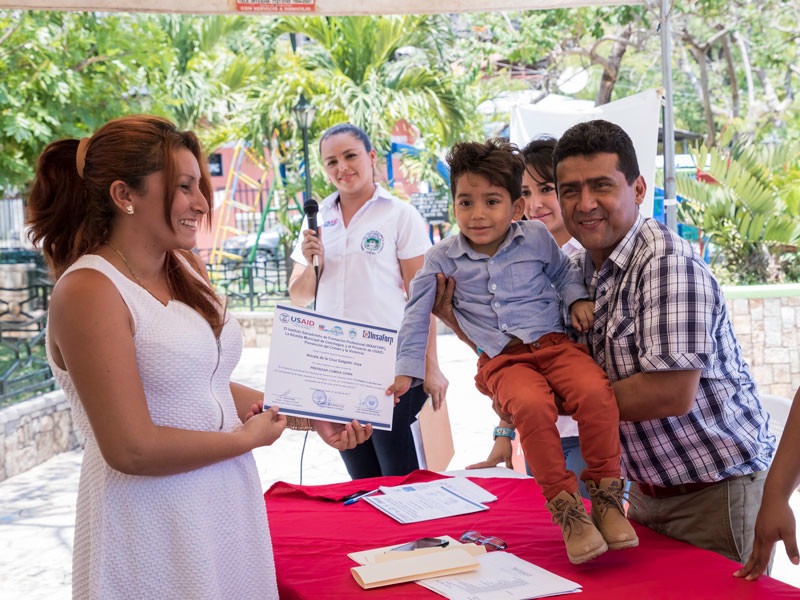
Su optimismo está respaldado por los números. Desde sus inicios en 2015, el 16 Se graduaron los Centros Municipales de Formación Profesional puestos en marcha con apoyo del proyecto 92 por ciento de los matriculados.
Mientras Mendoza estudia reparación de aire acondicionado, sus pares en todo el país están obteniendo la certificación en cómo preparar cocina internacional, visitas guiadas, reparar celulares, instalar cableado eléctrico doméstico y reparar motores fuera de borda para embarcaciones en las industrias de pesca y turismo. Proporcionando habilidades y empleos., El proyecto ofrece una alternativa positiva para los jóvenes que viven en zonas donde, en ausencia de estas oportunidades, Unirse a una pandilla puede parecer una elección viable para la seguridad económica..
Además de los centros de formato, El proyecto se asoció con Microsoft para lanzar nueve Microsoft Imagine Academies donde los jóvenes obtienen habilidades técnicas en demanda y obtienen certificaciones de Microsoft valoradas por posibles empleadores. Cerca de 1,450 Total Youth ya se han graduado con certificaciones, incluyendo a Jorge Fuentes, un estudiante universitario de 24 años.
Fuentes dice que el programa hace mucho más que agregar un logro valioso a los currículums.
"En un lugar como Cojutepeque, que se clasifica como uno de los municipios más violentos, Estos tipos de oportunidades nos dan una perspectiva diferente y nos hacen darnos cuenta de que hay muchas oportunidades para nosotros.," él dice. "No es solo un curso, es algo valioso que también ayuda a hacer amistades y nos permite conocer gente de diferentes campos y ampliar nuestro pensamiento”.
Cuando los jóvenes se gradúan de un centro FORMATE o Microsoft, Facilitadores de la Unidad Municipal de Empleo municipal, capacitado a través del proyecto, están listos para entrar en acción. Ayudan a los graduados a redactar currículums, reunirse con representantes de la empresa y prepararse para las entrevistas. Hasta la fecha, más que 1,000 Los jóvenes de todo el país han conseguido empleos a través de las unidades..
Prevención de la violencia liderada por la comunidad
A medida que el Proyecto de Prevención del Delito y la Violencia avanza hacia su último año, está trabajando para garantizar la continuidad de sus iniciativas a través de asociaciones con los gobiernos municipales, grupos de la sociedad civil y organizaciones sin fines de lucro. También está buscando enfoques únicos para la prevención de la violencia y la creación de oportunidades para jóvenes en riesgo.
"Actualmente, El proyecto está centrando su atención en la promoción de modelos innovadores para la prevención del crimen y la violencia., Desde asesoramiento familiar hasta prevención de violencia terciaria con una amplia variedad de organizaciones y entidades sociales,"Dice Karen Duarte, Coordinador del componente de subvenciones innovadoras del proyecto.
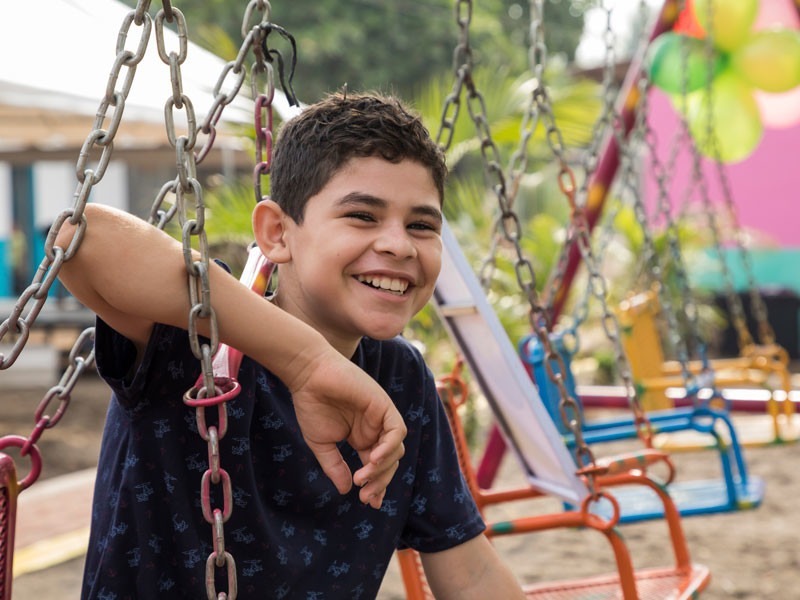
A través de asociaciones y subvenciones, El proyecto está respaldando iniciativas como sojautor (“Soy autor”), Darle a los jóvenes en riesgo la oportunidad de contar sus propias historias a través de la escritura, and Factoría Ciudadana ("Citizen Factory"), que apoya la rehabilitación y la reintegración social de jóvenes que han tenido problemas con la ley, luchó contra el abuso de sustancias, o haber sido deportado recientemente de los Estados Unidos.
Con recreación, Capacitación laboral y oportunidades sociales para los jóvenes., la reactivación de los espacios públicos y nuevas herramientas para los municipios y las fuerzas del orden, Municipios como Cojutepeque se están volviendo más resilientes en un país que todavía tiene una de las tasas de homicidios más altas del mundo..
para alexis, El asesoramiento familiar del proyecto le ha ayudado a empezar a soñar en grande.: Espera convertirse algún día en médico o piloto.. Alexis dice que alentaría a sus compañeros a buscar oportunidades similares para lograr cambios positivos en sus vidas y en sus comunidades..
“Justo cómo me hizo cambiar, puede cambiar a muchas más personas," él dice. “Así que no rechacen oportunidades como ésta., porque es algo realmente bueno”.
Con reportaje desde El Salvador de Marta Maldonado y Amanda Smallwood y edición de Gerson Lara y Evelyn Rupert..
